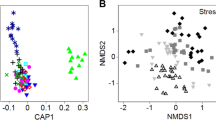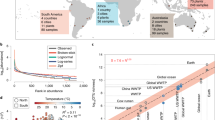Abstract
The relationship between functional redundancy and microbial community structure–diversity was examined using laboratory incubations to ensure constant environmental conditions. Serial dilutions of a sewage microbial community were prepared, used to inoculate sterile sewage, and maintained in batch culture. Probability suggests that dilution of the initial community should remove rare organism types, creating mixtures of cells differing in diversity. Regrowth of the diluted mixtures generated communities similar in abundance but differing in community structure and relative diversity (as determined using two DNA fingerprinting techniques and dilution-to-extinction analysis of community-level physiological profiles). The in situ function of each regrown community was examined by monitoring the short-term uptake of five different 14C-labeled compounds (glucose, acetate, citrate, palmitic acid, and an amino acid mixture). No significant differences were detected between treatments in either the rate of uptake of a substrate or the efficiency with which each community assimilated each compound. The fact that the activity of the original community was the same as that of a community regrown from an inoculum containing fewer that 100 cells (10−6 dilution) indicates that functional redundancy was quite high in this system. For each organism type eliminated during the dilution process, at least one of the remaining types was able to provide the same function at the same level as the lost one. Further research is necessary to determine what impact this functional redundancy may have on overall ecosystem function and stability.



Similar content being viewed by others
References
Atlas, RM, Horowitz, A, Krichevsky, M, Bej, AK (1991) Response of microbial-populations to environmental disturbance. Microb Ecol 22: 249–256
Beare, MH, Coleman, DC, Crossley, DA, Hendrix, PF, Odum, EP (1995) A hierarchical approach to evaluating the significance of soil biodiversity to biogeochemical cycling. Plant Soil 170: 5–22
Briones, A, Raskin, L (2003) Diversity and dynamics of microbial communities in engineered environments and their implications for process stability. Curr Opin Biotechnol 14: 270–276
Chapin, III, FS, Walker, BH, Hobbs, RJ, Hooper, DU, Lawton, JH, Sala, OE, Tilman, D (1997) Biotic control over the functioning of ecosystems. Science 277: 500–503
Degens, BP (1998) Decreases in microbial functional diversity do not result in corresponding changes in decomposition under different moisture conditions. Soil Biol Biochem 30: 1989–2000
Degens, BP, Schipper, LA, Sparling, GP, Duncan, LC (2001) Is the microbial community in a soil with reduced catabolic diversity less resistant to stress or disturbance? Soil Biol Biochem 33: 1143–1153
Dickens, HE, Anderson, JM (1999) Manipulation of soil microbial community structure in bog and forest soils using chloroform fumigation. Soil Biol Biochem 31: 2049–2058
Dunbar, J, Ticknor, LO, Kuske, CR (2000) Assessment of microbial diversity in four southwestern United States soils by 16S rRNA gene terminal restriction fragment analysis. Appl Environ Microbiol 66: 2943–2950
Elton, CS (1958) The Ecology of Invasions by Plants and Animals. Chapman and Hall. London
Fernandez, A, Huang, SY, Seston, S, Xing, J, Hickey, R, Criddle, C, Tiedje, J (1999) How stable is stable? Function versus community composition. Appl Environ Microbiol 65: 3697–3704
Finlay, BJ, Maberly, SC, Cooper, JI (1997) Microbial diversity and ecosystem function. Oikos 80: 209–213
Franklin, RB, Garland, JL, Bolster, CH, Mills, AL (2001) Impact of dilution on microbial community structure and functional potential: comparison of numerical simulations and batch culture experiments. Appl Environ Microbiol 67: 702–712
Garland, JL, Lehman, RM (1999) Dilution/extinction of community phenotypic characters to estimate relative structural diversity in mixed communities. FEMS Microbiol Ecol 30: 333–343
Garland, JL, Mills, AL, Morales, A, Cook, K (1999) Survival of human-associated bacteria in prototype advanced life support systems. SAE Tech. Paper Series No. 1999-01-2601
Ghilarov, AM (1997) Species redundancy versus non-redundancy: is it worth further discussion? Z Obs Biol 58: 100–105
Gitay, H, Wilson, JB, Lee, WG (1996) Species redundancy: a redundant concept? J Ecol 84: 121–124
Gower, JC (1966) Some distance properties of latent root and vector methods used in multivariate analysis. Biometrika 53: 325–338
Griffiths, BS, Ritz, K, Wheatley, R, Kuan, HL, Boag, B, Christensen, S, Ekelund, F, Sorensen, SJ, Muller, S, Bloem, J (2001) An examination of the biodiversity-ecosystem function relationship in arable soil microbial communities. Soil Biol Biochem 33: 1713–1722
Griffiths, BS, Ritz, K, Bardgett, RD, Cook, R, Christensen, S, Ekelund, SJ, Sorensen, SJ, Baath, E, Bloem, J, deRuiter, PC, Dolfing, J, Nicolardot, B (2000) Ecosystem response of pasture soil communities to fumigation-induced microbial diversity reductions: an examination of the biodiversity-ecosystem function relationship. Oikos 90: 279–294
Griffiths, BS, Ritz, K, Wheatley, RE (1997) Relationship between functional diversity and genetic diversity in complex microbial communities. In: Insam, H, Rangger, A (Eds.) Microbial Communities. Functional versus Structural Approaches. Springer-Verlag. Germany, pp 1–9
Grime, JP (1997) Biodiversity and ecosystem function: the debate deepens. Science 277: 1260–1261
Hobbie, JE, Daley, RJ, Jasper, S (1977) Use of Nuclepore filters for counting bacteria by fluorescent microscopy. Appl Environ Microbiol 33: 1225–1228
Hooper, DU, Vitousek, PM (1997) The effects of plant composition and diversity on ecosystem processes. Science 277: 1302–1305
Hughes, JB, Hellmann, JJ, Ricketts, TH, Bohannan, BJM (2001) Counting the uncountable: statistical approaches to estimating microbial diversity. Appl Environ Microbiol 67: 4399–4406
Hutchinson, GE (1959) Homage to Santa Rosalia, or why are there so many kinds of animals? Am Nat 93: 145–159
Kandeler, E, Kampichler, C, Horak, O (1996) Influence of heavy metals on the functional diversity of soil microbial communities. Biol Fertil Soils 23: 299–306
Kennedy, AC, Smith, KL (1995) Soil microbial diversity and the sustainability of agricultural soils. Plant Soil 170: 75–86
Klein, DA, Metzger, WC, Frederick, BA, Redente, EF (1986) Environmental stress–functional diversity relationships in semiarid terrestrial microbial communities. In: Jensen, V, Kjoller, A, Sorensen, LH (Eds.) Microbial Communities in Soil. Elsevier Applied Science Publishers. London, pp 105–112
King, GM (2002) Radiotracer (14C and 3H) assays for benthic microbial organic matter transformations. In: Hurst, CJ, Crawford, GR, Knudsen, GR, McInerney, MJ, Stetzenback, LD (Eds.) Manual of Environmental Microbiology. ASM Press. Washington, DC, pp 419–426
Legendre, P, Legendre, L (1998) Numerical Ecology. Elsevier Scientific Publishing Company. Amsterdam
Liu, W, Marsh, TL, Cheng, H, Forney, LJ (1997) Characterization of microbial diversity by determining terminal restriction fragment length polymorphisms of genes encoding 16S rRNA. Appl Environ Microbiol 63: 4516–4522
MacArthur, RH (1957) On the relative abundance of bird species. Proc Natl Acad Sci USA 43: 293–295
Mantel, N (1967) The detection of disease clustering and a generalized regression approach. Cancer Res 27: 209–220
Matos, A, Kerkhof, L, Garland, JL (2005) Effects of microbial community diversity on the survival of Pseudomonas aeruginosa in the wheat rhizosphere. Mirobiol Ecol 49: 257–624
McGrady-Steed, J, Harris, PM, Morin, PJ (1997) Biodiversity regulates ecosystem predictability. Nature 390: 162–165
Mikola, J, Setala, H (1998) Relating species diversity to ecosystem functioning: mechanistic backgrounds and experimental approach with a decomposer food web. Oikos 83: 180–194
Miller, M (1999) MANTEL-STRUCT: a program for the detection of population structure via Mantel tests. J Heredity 90: 258–259
Naeem, S, Li, SB (1997) Biodiversity enhances ecosystem reliability. Nature 390: 507–509
Naeem, S, Thompson, LJ, Lawler, SP, Lawton, JH, Woodfin, RM (1994) Declining biodiversity can alter the performance of ecosystems. Nature 368: 734–737
Odum, EP (1983) Basic Ecology. Saunders College Publishing. Philadelphia
Pielou, EC (1975) Ecological Diversity. John Wiley & Sons. Inc., New York
Rasmussen, LD, Sorensen, SJ (2001) Effects of mercury contamination on the culturable heterotrophic, functional and genetic diversity of the bacterial community in soil. FEMS Microbiol Ecol 36: 1–9
Salonius, PO (1981) Metabolic capabilities of forest soil microbial populations with reduced species diversity. Soil Biol Biochem 13: 1–10
Sneath, PH, Sokal, RR (1973) Numerical Taxonomy. W.H. Freeman and Company. San Francisco
Sokal, R (1979) Testing statistical significance of geographic variation patterns. Syst Zool 28: 227–232
Tate, RL (1997) Soil microbial diversity research: whither to now? Soil Sci 162: 605–606
Tilman, D (1996) Biodiversity: population versus ecosystem stability. Ecology 77: 350–363
Tilman, D, Downing, JA (1994) Biodiversity and stability in grasslands. Nature 367: 363–365
Tilman, D, Knops, J, Wedin, D, Reich, P, Ritchie, M, Siemann, E (1997) The influence of functional diversity and composition on ecosystem processes. Science 277: 1300–1302
Tilman, D, Wedin, D, Knops, J (1996) Productivity and sustainability influenced by biodiversity in grassland ecosystems. Nature 379: 718–720
Torsvik, V, Ovreas, L, Thingstad, TF (2002) Prokaryotic diversity—magnitude, dynamics, and controlling factors. Science 296: 1064–1066
Toyota, K, Ritz, K, Keel, C (1999) Impact of fumigation with metam sodium upon soil microbial community structure in two Japanese soils. Soil Sci Plant Nutr 45: 207–223
Wardle, DA, Giller, KE (1996) The quest for a contemporary ecological dimension to soil biology. Soil Biol Biochem 28: 1549–1554
Wenderoth, DF, Reber, HH (1999) Correlation between structural diversity and catabolic versatility of metal-affected prototrophic bacteria in soil. Soil Biol Biochem 31: 345–352
White, DC (1995) Chemical ecology: possible linkage between macro- and microbial ecology. Oikos 74: 177–184
Wright, RT, Burnison, BK (1979) Heterotrophic activity measured with radiolabelled organic substrates. In: Costerton JW, Colwell RR (Eds.) Native Aquatic Bacteria: Enumeration, Activity, and Ecology. ASTM STP 695. American Society for Testing and Materials. Conshohocken, pp 140–155
Wu, XL, Chin, KJ, Conrad, R (2002) Effect of temperature stress on structure and function of the methanogenic archaeal community in a rice field soil. FEMS Microbiol Ecol 39: 211–218
Yin, B, Crowley, D, Sparovek, G, De Melo, WJ, Borneman, J (2000) Bacterial functional redundancy along a soil reclamation gradient. Appl Environ Microbiol 66: 4361–4365
Zabeau, M, Vos, P (1993) Selective restriction fragment amplification: a general method for DNA fingerprinting, European Patent Office Publication No. EP 0534858 A1
Zak, JC, Willig, MR, Moorhead, DL, Wildman, HG (1994) Functional diversity of microbial communities—a quantitative approach. Soil Biol Biochem 26: 1101–1108
Zelles, L, Palojarvi, A, Kandeler, E, Von Lutzow, M, Winter, K, Bai, QY (1997) Changes in soil microbial properties and phospholipid fatty acid fractions after chloroform fumigation. Soil Biol Biochem 29: 1325–1336
Acknowledgments
This work was supported by a NASA GSRP grant (NGT10-52620) and the University of Virginia Department of Environmental Sciences' Moore Research Award. The authors would like to acknowledge Sarika Rhode Chaudhary, Michael Lowit, Linda Blum, Kathleen Daumer, and Michael Roberts for assistance with laboratory work.
Author information
Authors and Affiliations
Corresponding author
Rights and permissions
About this article
Cite this article
Franklin, R.B., Mills, A.L. Structural and Functional Responses of a Sewage Microbial Community to Dilution-Induced Reductions in Diversity. Microb Ecol 52, 280–288 (2006). https://doi.org/10.1007/s00248-006-9033-0
Received:
Accepted:
Published:
Issue Date:
DOI: https://doi.org/10.1007/s00248-006-9033-0




